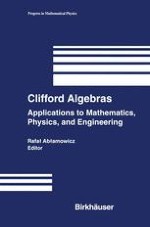2004 | OriginalPaper | Buchkapitel
Transposition in Clifford Algebra: SU(3) from Reorientation Invariance
verfasst von : Bernd Schmeikal
Erschienen in: Clifford Algebras
Verlag: Birkhäuser Boston
Enthalten in: Professional Book Archive
Aktivieren Sie unsere intelligente Suche, um passende Fachinhalte oder Patente zu finden.
Wählen Sie Textabschnitte aus um mit Künstlicher Intelligenz passenden Patente zu finden. powered by
Markieren Sie Textabschnitte, um KI-gestützt weitere passende Inhalte zu finden. powered by
Recoding base elements in a spacetime algebra is an act of cognition. But at the same time this act refers to the process of nature. That is, the internal interactions with their standard symmetries reconstruct the orientation of spacetime. This can best be represented in the Clifford algebra Cl3, 1 of the Minkowski spacetime. Recoding is carried out by the involutive automorphism of transposition. The set of transpositions of erzeugende Einheiten (primitive idempotents), as Hermann Weyl called them, generates a finite group: the reorientation group of the Clifford algebra. Invariance of physics laws with respect to recoding is not a mere matter of computing, but one of physics. One is able to derive multiplets of strong interacting matter from the recoding invariance of Cl3, 1 alone. So the SU(3) flavor symmetry essentially turns out to be a spacetime group. The original quark multiplet independently found by Gell-Mann and Zweig is reconstructed from Clifford algebraic eigenvalue equations of isospin, hypercharge, charge, baryon number and flavors treated as geometric operators. Proofs are given by constructing six possible commutative color spinor spaces ℂhχ, or color tetrads, in the noncommutative geometry of the Clifford algebra Cl3, 1 Calculations are carried out with CLIFFORD, Maple V package for Clifford algebra computations. Color spinor spaces are isomorphic with the quaternary ring 4ℝ = ℝ ⊕ ℝ ⊕ ℝ ⊕ ℝ. Thus, the differential (Dirac) operator takes a very handsome form and equations of motion can be handled easily. Surprisingly, elements of Cl3, 1 representing generators of SU(3) bring forth (1) the well-known grade-preserving transformations of the Lorentz group together with (2) the heterodimensional Lorentz transformations, as Jose Vargas denoted them: Lorentz transformations of inhomogeneous differential forms. That is, trigonal tetrahedral rotations do not preserve the grade of a multivector but instead, they permute the base elements of the color tetrad having grades 0, 1, 2 and 3. In the present model the elements of each color space are exploited to reconstruct the flavor SU(3) such that each single commutative space contains three flavors and one color. Clearly, the six color spaces do not commute, and color rotations act in the noncommutative geometry. To give you a picture: Euclidean space with its reorientation group, i.e., the again embed the root spaces of the 6 flavor su(3). Color su(3) is exact because it does not involve relativistic effects. Flavor does and is therefore inexact. It seems that Cl3, 1 comprises enough structure for both the color- and the flavor-SU(3). In this very first approach both symmetries are reconstructed exact, whereas in reality the flavor SU(3) is only approximate. Here, the only way to make a difference between a color- and a flavor-rotation may be to distinguish between commutative and noncommutative geometry.We conclude that an extended heterodimensional Lorentz invariance of the Minkowski spacetime and the SU(3) of strongly interacting quarks result from each other. This involves a nongrade preserving-degree of freedom of motion taking spatial lines to spacetime areas and areas to spacetime-volumes and back to lines and areas. Although the form of the Dirac equation is preserved, a thorough study of the involved nonlinearities of equations of motion is still outstanding.
